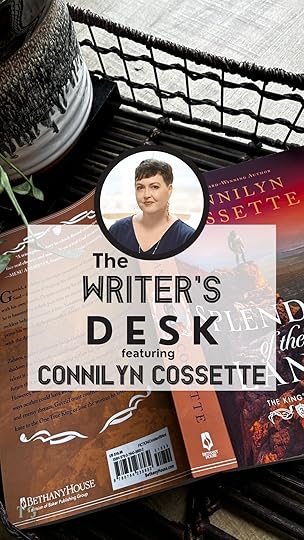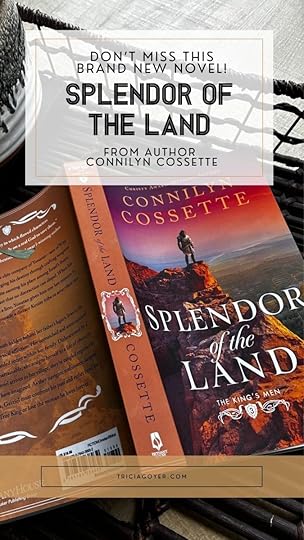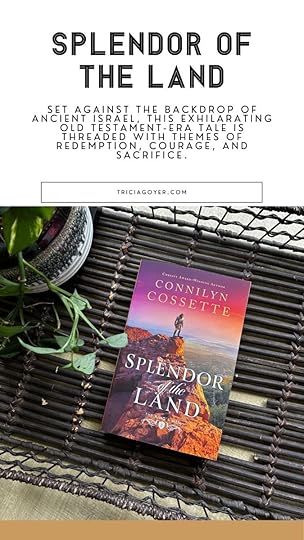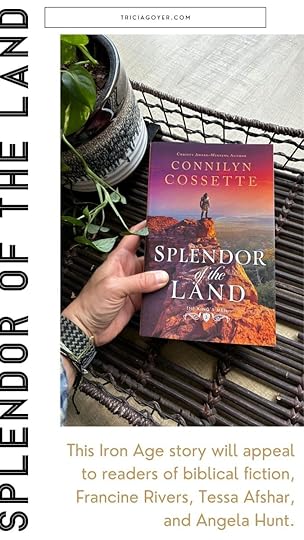Writer’s Desk with Connilyn Cossette
 Tricia Goyer
Tricia GoyerConnilyn Cossette is a Christy Award-winning and bestselling author of stories that illuminate the ancient world of the Bible, in the hope her readers will dig deeper into the Word and encounter the Great Storyteller himself. A recent breast cancer survivor and adoptive mom of her two greatest gifts, she and her husband live in a small town south of Dallas, Texas.
Connect with Connilyn on her website, Instagram, Facebook, X, BookBub, join her Facebook group, and don’t forget to subscribe to her newsletter on her website.
More about Splendor of the LandGavriel, a soldier in the elite company of Yonatan–son of King Saul–dreams of forging his destiny through crafting weapons with his own hands. Despite earning his place among Israel’s finest, he is haunted by a dark past that no distraction can dispel. When his reckless behavior crosses a line, Yonatan gives him one last mission to prove his worth: help persuade a distant Kenite tribe to sever their ties with the Amalekites.
Zahava, a gifted goldsmith hidden behind her father’s legacy, lives in the shadows due to her physical affliction. Her unmatched and unrecognized talent is a closely guarded secret within her family. Disheartened by a future that seems unattainable, she resigns herself to a life of obscurity. However, when Gavriel arrives in her village, they’re tangled together in ways neither could have imagined. As they navigate unforeseen dangers and enemy threats, Gavriel must confront his past and either bend his knee to the One True King or lose the woman he loves forever.
Purchase a copy of Splendor of the Land.
Enter to Win a Copy of Splendor of the LandQ&A with Connilyn CossetteARCF: Can you tell us a little about Splendor of the Land and the inspiration behind it?
CC: In the third book of the King’s Men series, Gavriel has spent years spying for Israel under Yonatan, King Saul’s son, while fighting to outrun his past. When his reckless choices force a reassignment, he’s given one more chance to prove himself by helping to lead the Kenite people to safety. That’s where he crosses paths with Zahava, a young woman with a hidden gift for goldsmithing and a condition that keeps her in the shadows. Neither of them is prepared for what happens when their destinies collide. Since I’d already written two full-length books and two novellas where Gavi makes his presence known–and not always in a positive way– I was excited to dig into his story, and his past, and give him the redemption arc I always planned for him. He may have a seriously rocky start from page one, but that just makes the ending, for both Gavi and Zahava, so much more satisfying.
ARCF: Splendor of the Land is set in ancient Israel. What inspired you to choose this particular time and place for your story?
CC: It really was because of my own curiosity about the early years of King Saul’s reign and a desire to “slow down” and explore what things might have been like after the end of the Judges era. Israel had been governed by tribal leaders for hundreds of years, and I imagined the abrupt shift toward a central government under one king might have been a rough transition for a bunch of stubborn people who’d never really meshed well from the beginning, when Jacob’s sons walked the earth. I also thought it would be interesting to explore what it would have been like for those excited about the first king of Israel to gradually become disillusioned with his impulsive and increasingly selfish behavior over the years. The cousins in the King’s Men series have four differing perspectives on Saul from the start, but each of them gradually discovers they’ve been serving the wrong King all along.
ARCF: The novel features Gavriel, a soldier in Yonatan’s elite company. How does his military background influence his character development?
CC: Gavriel’s years as a soldier have turned him into the exact thing he hates the most. The things he’s done and the guilt he carries have pushed him into reckless choices and the bottom of too many wine cups. The discipline and honor he once had have given way to bitterness and self-destruction. He’ll be forced to confront what his life has become and decide whether he’s willing to surrender everything to the King above all kings or lose those he loves the most.
ARCF: Zahava, a gifted goldsmith, lives in the shadows due to her physical affliction. How does her condition shape her interactions with others and her role in the story?
CC: Zahava’s condition has left her feeling small and unseen, and over the years that’s chipped away at her confidence. She’s learned to hide in the background, keeping her true talent and her true self out of sight, because she’s convinced she’ll only be rejected. That fear shapes how she sees herself, how she relates to others, and even how she understands Yahweh’s nature. When she meets Gavi and her world is turned upside down, she will be tested in ways she never expected and, in seeking the Most High, will find strength she never knew she had.
ARCF: If Splendor of the Land was optioned for film, who would your dream cast be?
CC: I don’t usually think of known actors when I imagine my characters (it messes with my imagination too much), but I have to say that Cam Yaman, a Turkish actor, looks so much like the Gavriel in my head and would probably play that rugged, tortured soul quite well. There’s also a British actress named Aiysha Hart who looks so much like I imagine Zahava and would carry the role of a shy young woman with a secret ability quite well.
ARCF: The backdrop of ancient Israel provides a rich setting. How did you incorporate historical and cultural details to bring this era to life?
CC: I have a pretty strong base of knowledge when it comes to early Iron Age Israel, but I wanted to weave in some strong details about ancient metalworking and jewelry-making in this book, since the Kenites in the Bible were known as metalworkers. My rabbit trail of research led me to Punon, now called Wadi Feynan, which has evidence of copper mining going back thousands of years, which turned out to be the perfect setting for Zahava’s family and the showdown with the Amalekites. I also delved into the ancient technique of lost-wax casting, which involves creating intricate wax patterns to mold metal, a perfect way for Zahava to create her treasures with simple tools. Since there is little more we know about the Kenites, I tried to incorporate some ancient Bedouin traditions and ambiance since the Kenites were likely similarly nomadic from time to time.
ARCF: The novel touches on themes of redemption, courage, and sacrifice. How do these themes manifest through the characters’ journeys?
CC: Those themes are really at the heart of the story for me. Gavriel’s journey is all about redemption—he’s made choices that he can’t forgive himself for, and he’s convinced he’s beyond saving. But little by little, he’s faced with the question of whether he’ll keep running from grace or finally surrender to it. Zahava has spent so much of her life hiding, letting fear decide for her, and now she has to find the bravery to step into the light and believe she’s worth more than her affliction. And for both of them, sacrifice comes into play as they learn what it means to lay down their own pride and comfort for the sake of those they love. These common threads really weave through everything they experience as they move closer to each other and to Yahweh.
ARCF: Your writing process involves visualizing scenes and layering sensory details. How does this approach enhance the storytelling in Splendor of the Land?
CC: I am a very visual person to begin with, so I spend a lot of time daydreaming about how my scenes play out and see most of it unfold like a movie in my head. Once I’ve gotten the bones of my story down, my second and third edits involve more layering of sensory details by imagining what my characters would perceive with their five senses in every single scene and how they might react to those perceptions. Since my goal has always been to make readers feel like they are experiencing events in the Bible for themselves, I feel like this careful attention to detail is a really important step in my process.
ARCF: You’ve mentioned that your first manuscript took five years to complete. How has your writing process evolved since then?
CC: When I first started writing, I had no idea how to plot a book or how to take it from conception to publication. So I spent much of those five years teaching myself and studying others’ work in order to learn from them. But I still was what you would call a “pantser” and mostly followed wherever my imagination took me (within the bounds of the Biblical narrative). Over the years, I’ve evolved quite a bit. I am now more of a hybrid panster/plotter. I start by plotting the overall story with my plotting group at our yearly retreat and then build the plot loosely based on a Four Act structure by writing up a quick synopsis of each chapter–although I always allow for changes along the way. When I’m ready to write, I start by sketching out each chapter by hand in a mind map format before handwriting it all into a notebook as quickly as possible to keep my inner editor at bay. While I enter my finished chapter into the computer, I edit and expand on what I have written. Then, of course, there are a few more rounds of edits until it’s ready for publication. There are times when my usual process isn’t possible (mostly if I’ve procrastinated too much), but for the most part, this system has become my normal rhythm.
ARCF: The Philistines are portrayed as an advanced civilization in the novel. How did you incorporate historical facts about their culture into the story?
CC: A few years ago, DNA evidence proved that the Philistines originated on the European continent, then over time came down through Crete (Biblical Caphtor) and made their way to the shores of Canaan. Although we don’t have all that much information about the Philistines, mostly due to political restrictions for archeology in modern Israel, we do have lots of intriguing background and material culture from the Aegean people (the Myceneans and Minoans) who were likely related to the Philistines and certainly traded both goods and ideas with them. So with that background in mind, and using what I learned from digs where the Philistines lived, I developed a culture that was highly influenced by Aegean roots, religion, and language. It was fascinating to learn that these people had actual indoor plumbing and carefully planned high-rise cities complete with sewer systems, as well as highly developed architecture and surprisingly skilled artistry. I would guess with how “cosmopolitan” the Philistines likely considered themselves, the shepherds and farmers of Israel would seem quite backward indeed–and both the land and the people ripe for conquering. Too bad for them, Yahweh had other plans…
ARCF: Splendor of the Land is part of The King’s Men series. Can the books in this series be read as stand alone, or do they need to be read in order?
CC: They can possibly be read as stand-alone but are much more enjoyable to read in order, as well as with the companion novellas I’ve been writing for each release, which take place when the King’s Men are just boys, long before they are the heroes they will someday become. As well, there is some great background information in Between the Wild Branches from the Covenant House series, which is where the four cousins first appear when they are young.
ARCF: And finally, can you share what’s coming up next for you?
CC: Next year, I will be releasing the fourth book in the King’s Men series (along with a fourth novella) so the answers readers have been dying for since the beginning will finally be revealed. It will be hard to leave the King’s Men in the past once it’s all complete, since I’ve been journeying with them since 2020 when the idea first came into being, but I have an exciting new series already percolating in my brain, along with ideas for a novella I’ve been wanting to sink my teeth into for a long time. That’s all I can say for now, though!


 The post Writer’s Desk with Connilyn Cossette appeared first on Tricia Goyer.
The post Writer’s Desk with Connilyn Cossette appeared first on Tricia Goyer.



